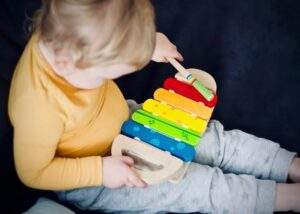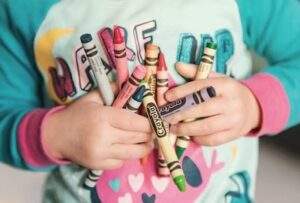As toddlers move independently and gain more control of their bodies, their natural curiosity about anatomy kicks into high gear. Guiding these early inquiries into developmental learning opportunities helps foster positive self-awareness, provide answers to satisfy their budding inquisitiveness, and lay the foundation for healthy habits that can last a lifetime. Making the identification of body parts engaging, interactive games, songs and activities is key to honing these skills while keeping young minds entertained.
Here are some engaging ways to introduce body parts that delight your little explorer.

Toddlers curiously touch or point to their nose, ears, belly button, and other body areas.
The Mirror Game
Stand with your toddler in front of a full-length mirror. Point to different areas on your body, like “this is Mommy’s nose,” and have them mimic you to find the same places on themselves. Clap and cheer when they locate a part. This interactive mirror play makes learning a fun game.
Body Part Books
Examine board books with photos of smiling children happily pointing at eyes, ears, knees, and more. Reading together each day builds identification skills while fueling their enthusiasm. Remember to pepper in questions to check comprehension.
“Where is Your Nose?” by Robert Schenkel invites young readers on an engaging educational adventure. Each page playfully encourages kindergarteners to become involved and familiar with their bodies through simple identification prompts.
Body Bingo
Make a bingo card with images of varied body parts. As you call out areas, have them search for touch, and isolate the right picture. Keep toddlers engaged by making it like a traditional game with rewards for scoring a bingo. The lively format keeps attention spans invested.
Interactive Anatomy Dolls
Soft dolls with labeled zippered flaps allow little fingers to explore independently. As they lift each tab to discover what’s underneath, read the body part name together. The tactile experience cements the vocabulary while igniting their innate drive to learn through play.
Body Song Time
Singing familiar tunes but inserting body parts like “head and shoulders, knees and toes” is a memorable way for information to sink in. Encourage dancing and acting it out for physical reinforcement. Your toddler will be humming and pointing out body areas in no time.
Bathing Bonanza
Bathtime provides the perfect opportunity to learn hands-on. Use a washcloth to wipe different zones while calling out each one gently. Let tiny fingers feel their ears, cheeks, and so on. Making washing engaging will keep them looking forward to this special time together.
By incorporating identification into play through interactive games, books, music, and more, you transform what could be a rote process into a joyful adventure your toddler will want to experience again and again. Their growing knowledge and confidence in such formative years will serve them well.
The Moving Body Discovery Adventure
As toddlers start walking, running, and climbing, seizing each physical milestone fuels their desire to learn what makes momentous movement possible. Expand vocabulary with descriptive action words for crawling, jumping, kicking, and more. Guide little arms and legs into bending, stretching, and twisting. Explaining how muscles, tendons, and bones work cooperatively builds comprehension and lays the foundations for lifelong wellness.

Learning the names of hands, feet, eyes, and other body parts sparks questions from inquisitive toddlers eager to understand their changing physical abilities.
Wrapping Up: Nourishing Curiosity Beyond Toddlerhood
Sustaining inquisitiveness as children grow requires ongoing guidance tailored to developing minds. School-age kids benefit from 3D anatomy models and downloadable body templates to color-identify parts. Health diagram books or interactive skeleton exhibits ignite deeper inquiries for older elementary students. Nurturing a lifelong love of learning about our amazing machines empowers kids to care for themselves with knowledge and wonder.
Teach kids all about their body with Rober Schenkel’s Where is Your Nose? Grab your copy now!

